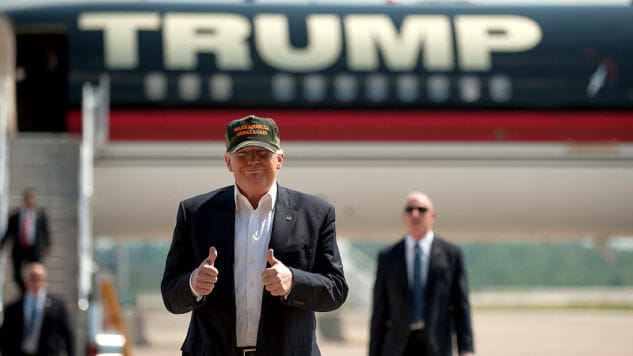With His Transparent Wall, Trump Hits Full Wonka
One nation, invisible
Jeff Swensen / Getty
My fellow Americans, we are now at peak lucid dreaming.
Trump talked about his One True Wall. According to the Post:
President Trump told reporters on Air Force One on Wednesday that his proposed border wall would have to be “transparent” to prevent Americans from being struck and killed by 60-pound sacks of drugs tossed over from the Mexican side.
This was already totally rational, but the President—ever the perfectionist—continued, just in case there were any doubters and haters in the plane:
“One of the things with the wall is you need transparency. You have to be able to see through it,” Trump said. He continued: “In other words, if you can’t see through that wall — so it could be a steel wall with openings, but you have to have openings because you have to see what’s on the other side of the wall. And I’ll give you an example. As horrible as it sounds, when they throw the large sacks of drugs over, and if you have people on the other side of the wall, you don’t see them — they hit you on the head with 60 pounds of stuff? It’s over. As crazy as that sounds, you need transparency through that wall.”
Yes, why not? I’m surprised he didn’t find room in the blueprints for fragments of the True Cross. The Post went on to describe the exacting technical specifications required for building “the drug trebuchet: a medieval-era device capable of slinging heavy objects, typically marijuana bales, across hundreds of yards.”
I see through his ambition, much as the narco cartels will see through the fabulous wall during the sundowning years of the American experiment. Like the veil of time or the band Tool, the Wall of Tomorrow lends itself to abstractions, visions. Given enough money and crayons, there is little doubt that the Commander-in-Chief could furnish several books of Poe-style visions for the see-through boundary: trick gates, guillotines, rude puns, swinging pendulums, the works. I have complete faith in his creative potential.
-

-

-

-

-

-

-

-

-

-

-

-

-

-

-

-

-

-

-

-

-

-

-

-

-

-

-

-

-

-

-

-

-

-

-

-

-

-

-

-








































